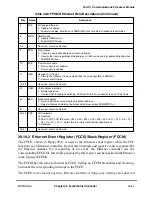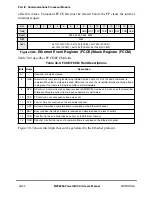
MOTOROLA
Chapter 31. FCC HDLC Controller
31-7
Part IV. Communications Processor Module
Table 31-5 describes HDLC reception errors, which are reported through the RxBD.
31.6 HDLC Mode Register (FPSMR)
When an FCC is conÞgured for HDLC mode, the FPSMR is used as the HDLC mode
register, shown in Figure 31-3.
Table 31-5. HDLC Reception Errors
Error Description
Overrun Error The HDLC controller maintains an internal FIFO buffer for receiving data. The CP begins
programming the SDMA channel and updating the CRC whenever data is received in the FIFO buffer.
When a receive FIFO overrun occurs, the channel writes the received data byte to the internal FIFO
buffer over the previously received byte. The previous byte and the frame status are lost. The channel
closes the buffer with RxBD[OV] set and generates the RXF interrupt if it is enabled. The receiver then
enters hunt mode. Even if the overrun occurs during a frame whose address is not matched in the
address recognition logic, an RxBD with data length two is opened to report the overrun and the RXF
interrupt is generated if it is enabled.
CD Lost
During Frame
Reception
When this error occurs, the channel terminates frame reception, closes the buffer, sets RxBD[CD],
and generates the RXF interrupt if it is enabled. This error has highest priority. The rest of the frame is
lost and other errors are not checked in that frame. At this point, the receiver enters hunt mode.
Abort
Sequence
The HDLC controller detects an abort sequence when seven or more consecutive ones are received.
When this error occurs and the HDLC controller receives a frame, the channel closes the buffer by
setting RxBD[AB] and generates the RXF interrupt (if enabled). The channel also increments the abort
sequence counter. The CRC and nonoctet error status conditions are not checked on aborted frames.
The receiver then enters hunt mode. When an abort sequence is received, the user is given no
indication that an HDLC controller is not currently receiving a frame.
Nonoctet
Aligned Frame
When this error occurs, the channel writes the received data to the data buffer, closes the buffer, sets
the Rx nonoctet aligned frame bit RxBD[NO], and generates the RXF interrupt (if it is enabled). The
CRC error status should be disregarded on nonoctet frames. After a nonoctet aligned frame is
received, the receiver enters hunt mode. An immediate back-to-back frame is still received. The
nonoctet data portion may be derived from the last byte in the buffer by Þnding the least-signiÞcant set
bit, which marks the end of valid data as follows:
msb
lsb
Valid data
1
0
0
0
CRC Error
When this error occurs, the channel writes the received CRC to the data buffer, closes the buffer, sets
RxBD[CR], and generates the RXF interrupt (if it is enabled). The channel also increments the CRC
error counter. After receiving a frame with a CRC error, the receiver enters hunt mode. An immediate
back-to-back frame is still received. CRC checking cannot be disabled, but the CRC error can be
ignored if checking is not required.
Summary of Contents for MPC8260 PowerQUICC II
Page 1: ...MPC8260UM D 4 1999 Rev 0 MPC8260 PowerQUICC II UserÕs Manual ª ª ...
Page 66: ...lxvi MPC8260 PowerQUICC II UserÕs Manual MOTOROLA ...
Page 88: ...1 18 MPC8260 PowerQUICC II UserÕs Manual MOTOROLA Part I Overview ...
Page 120: ...2 32 MPC8260 PowerQUICC II UserÕs Manual MOTOROLA Part I Overview ...
Page 138: ...Part II iv MPC8260 PowerQUICC II UserÕs Manual MOTOROLA Part II Configuration and Reset ...
Page 184: ...4 46 MPC8260 PowerQUICC II UserÕs Manual MOTOROLA Part II ConÞguration and Reset ...
Page 202: ...Part III vi MPC8260 PowerQUICC II UserÕs Manual MOTOROLA Part III The Hardware Interface ...
Page 266: ...8 34 MPC8260 PowerQUICC II UserÕs Manual MOTOROLA Part III The Hardware Interface ...
Page 382: ...10 106 MPC8260 PowerQUICC II UserÕs Manual MOTOROLA Part III The Hardware Interface ...
Page 392: ...11 10 MPC8260 PowerQUICC II UserÕs Manual MOTOROLA Part III The Hardware Interface ...
Page 430: ...Part IV viii MOTOROLA Part IV Communications Processor Module ...
Page 490: ...14 36 MPC8260 PowerQUICC II UserÕs Manual MOTOROLA Part IV Communications Processor Module ...
Page 524: ...17 10 MPC8260 PowerQUICC II UserÕs Manual MOTOROLA Part IV Communications Processor Module ...
Page 556: ...18 32 MPC8260 PowerQUICC II UserÕs Manual MOTOROLA Part IV Communications Processor Module ...
Page 584: ...19 28 MPC8260 PowerQUICC II UserÕs Manual MOTOROLA Part IV Communications Processor Module ...
Page 632: ...21 24 MPC8260 PowerQUICC II UserÕs Manual MOTOROLA Part IV Communications Processor Module ...
Page 652: ...22 20 MPC8260 PowerQUICC II UserÕs Manual MOTOROLA Part IV Communications Processor Module ...
Page 668: ...23 16 MPC8260 PowerQUICC II UserÕs Manual MOTOROLA Part IV Communications Processor Module ...
Page 758: ...27 28 MPC8260 PowerQUICC II UserÕs Manual MOTOROLA Part IV Communications Processor Module ...
Page 780: ...28 22 MPC8260 PowerQUICC II UserÕs Manual MOTOROLA Part IV Communications Processor Module ...
Page 874: ...29 94 MPC8260 PowerQUICC II UserÕs Manual MOTOROLA Part IV Communications Processor Module ...
Page 920: ...31 18 MPC8260 PowerQUICC II UserÕs Manual MOTOROLA Part IV Communications Processor Module ...
Page 980: ...A 4 MPC8260 PowerQUICC II UserÕs Manual MOTOROLA Appendixes ...
Page 1002: ...Index 22 MPC8260 PowerQUICC II UserÕs Manual MOTOROLA INDEX ...
Page 1006: ......
















































